These poppy seed yeast rolls are a popular European bakery classic, perfect for dessert or breakfast. A slightly sweet yeast dough is filled with a flavorful poppy seed filling and baked to perfection. The rolls can be prepared gluten-free or with regular flour, plus they are dairy-free, egg-free, and therefore, 100% vegan!
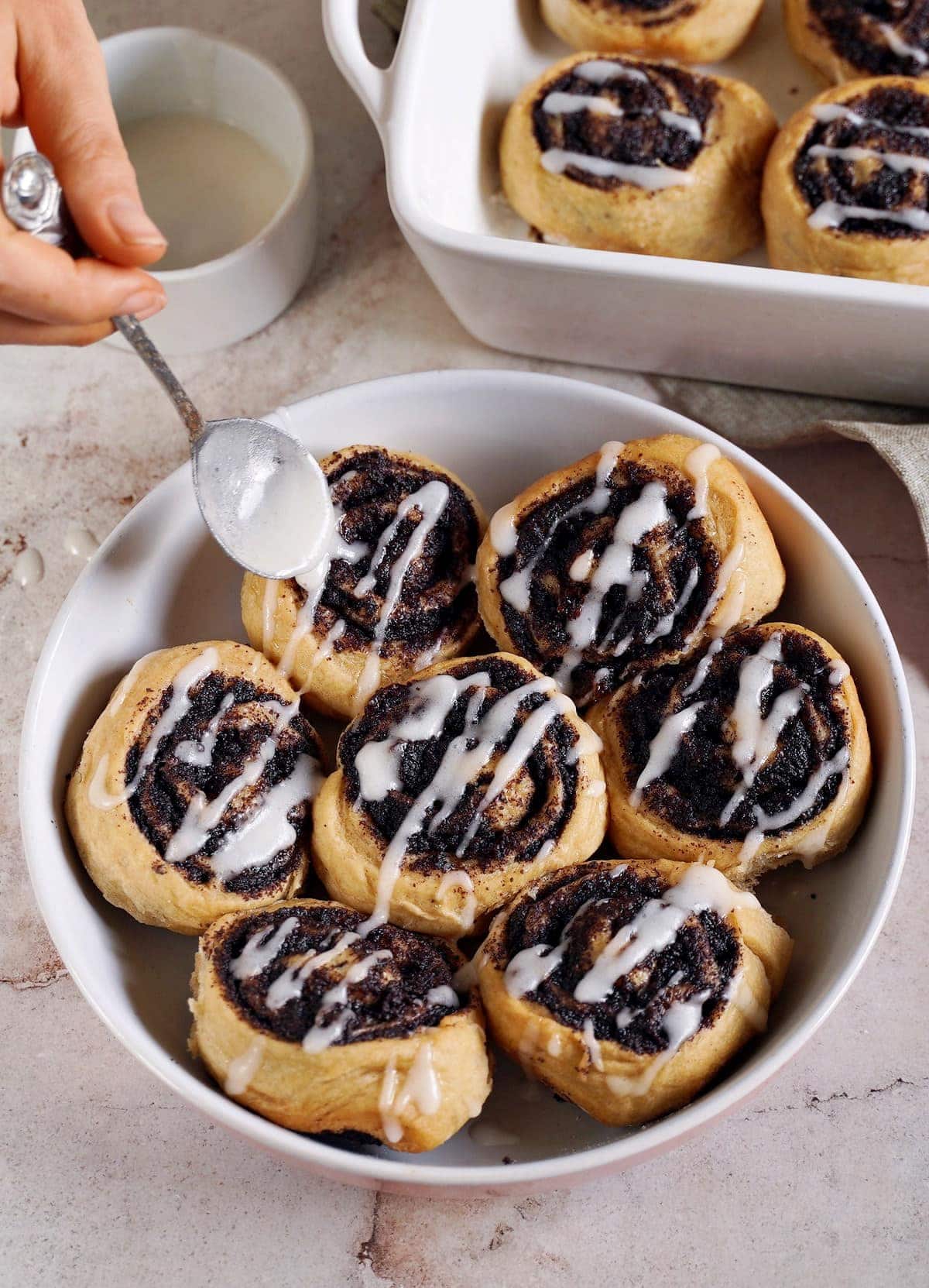
Having already shared several poppy seed recipes, including steamed yeast dumplings (Dampfnudeln) with a poppy seed filling, Kolache poppy seed pastries, and a layered vegan cheesecake, I’m now back again with poppy seed rolls!
This slightly sweet yeast bread is filled with a thick poppy seed filling and is super popular in Germany (called Mohnschnecken) and across lots of Central/ Eastern Europe, including the Czech Republic (makový závin), Poland (makowiec), Russia (рулет с маком), etc. In those countries, it is often baked as one large poppy seed roll ‘loaf.’ For this recipe, though, the yeast rolls are more like individual cinnamon rolls – but with poppy seeds!
The bake itself is traditionally not too sweet, so I’ve included an optional sweet glaze for those with a sweet tooth. I recommend baking up a batch and serving them warm from the oven with a big pot of tea (or coffee), delicious!
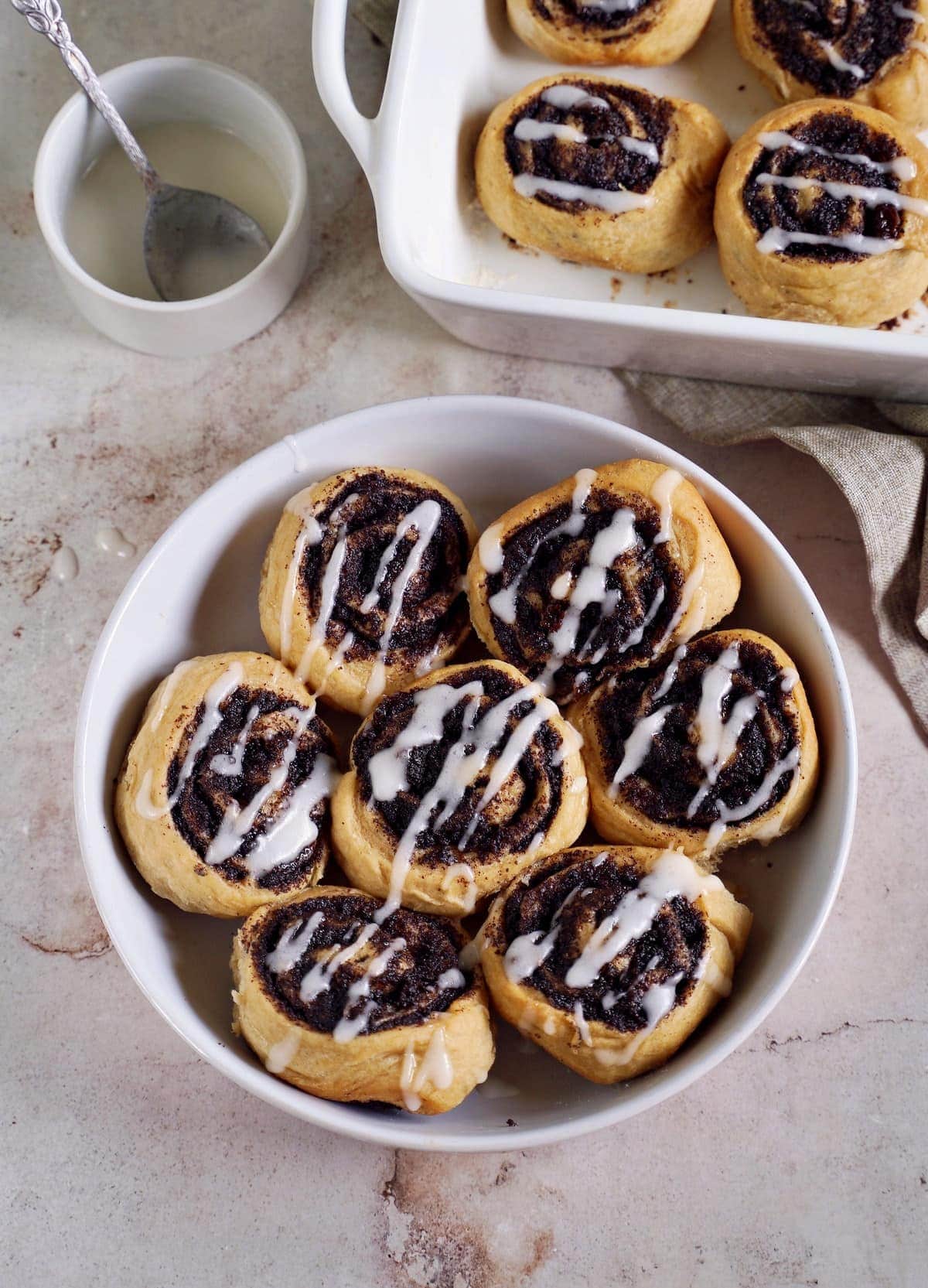
The Ingredients and Substitutions
The Gluten-Free Dough
- Dairy–free milk: You can use whatever milk you’d like; almond, coconut, rice, etc.
- Sugar: I recommend either cane sugar or coconut sugar. This helps feed the yeast and adds flavor, so don’t substitute it for a sugar-free alternative.
- Yeast: You can use fresh or dry yeast; check the recipe card for the correct amounts.
- Flours: I had the best gluten-free results with a combination of brown rice flour, buckwheat flour, and tapioca flour. There is also a non-GF version using AP flour in recipe card notes.
- Psyllium husk: This is critical in these gluten-free rolls to help the dough be more pliable (since it lacks gluten). Do NOT omit this ingredient! You may be able to substitute xanthan gum, though I haven’t tried.
- Apple cider vinegar: This helps to enhance the texture of the poppy seed rolls.
- Vegan butter
- Salt
The Poppy Seed Filling
- Poppy seeds: You may use pre-ground poppy seeds to save you a step.
- Dairy-free milk: Once again, whichever you’d prefer.
- Powdered sugar: aka icing sugar, or powdered Erythritol.
- Raisins: I use dark (not golden) raisins, though golden would also work.
Note: You could also purchase a ready-made ‘poppy seed filling.’ However, they’re often overly sweet due to the addition of corn syrup.
For the full ingredients list, measurements, complete recipe method, and nutritional information, please read the recipe card below.
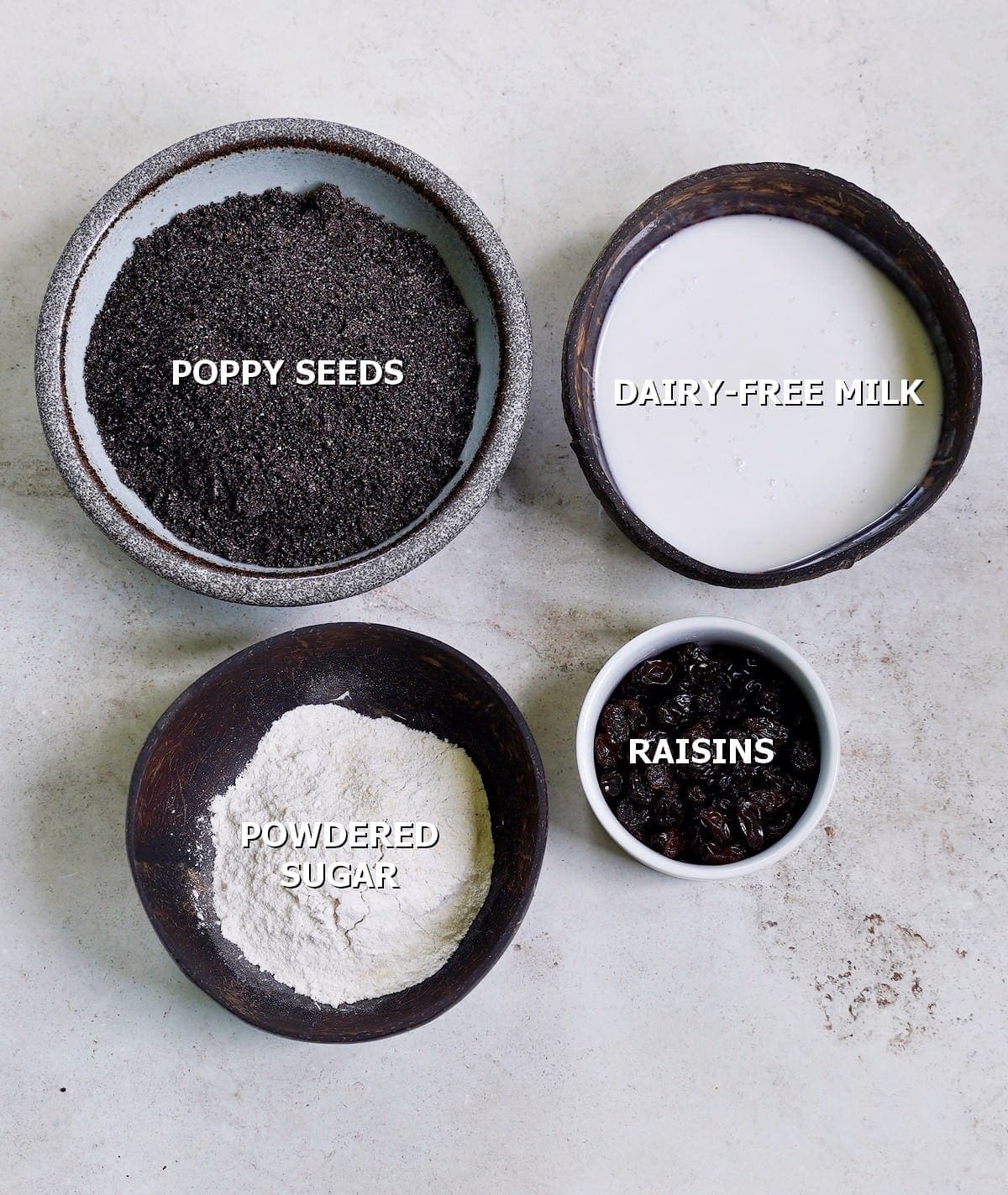
How to Make Poppy Seed Rolls
Step 1: Prepare the dough
- First, add the yeast and 1 teaspoon of sugar to a small saucepan and pour in the lukewarm milk (approx. 35-40° C / 100° F). Set aside for a few minutes to activate the yeast.
- Then, combine the flours, psyllium husk powder, salt, and remaining sugar in a large bowl and whisk to combine.
- Add the yeast mixture and butter to the dry ingredients. Then use your hands or a stand mixer (with dough hook) to knead the dough for a few minutes until smooth.
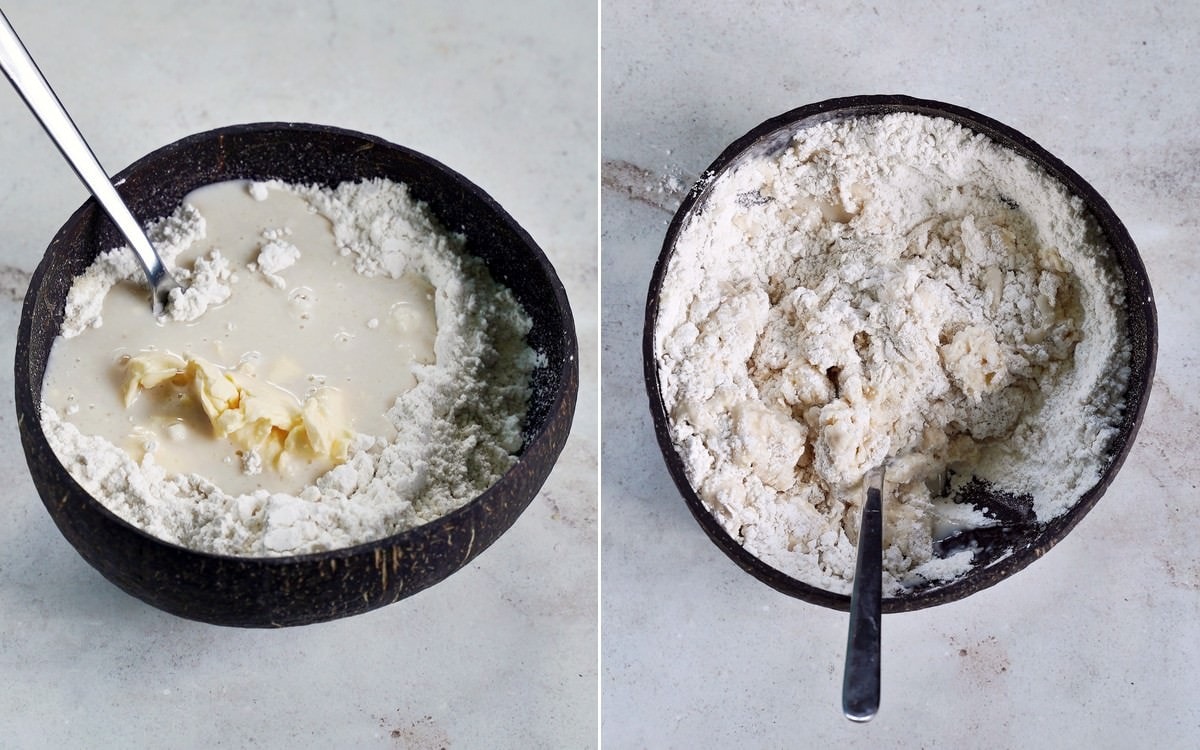
- Place the dough back in the bowl, cover it with a damp towel, and transfer it to a warm location to allow the dough to rise for 60 minutes.
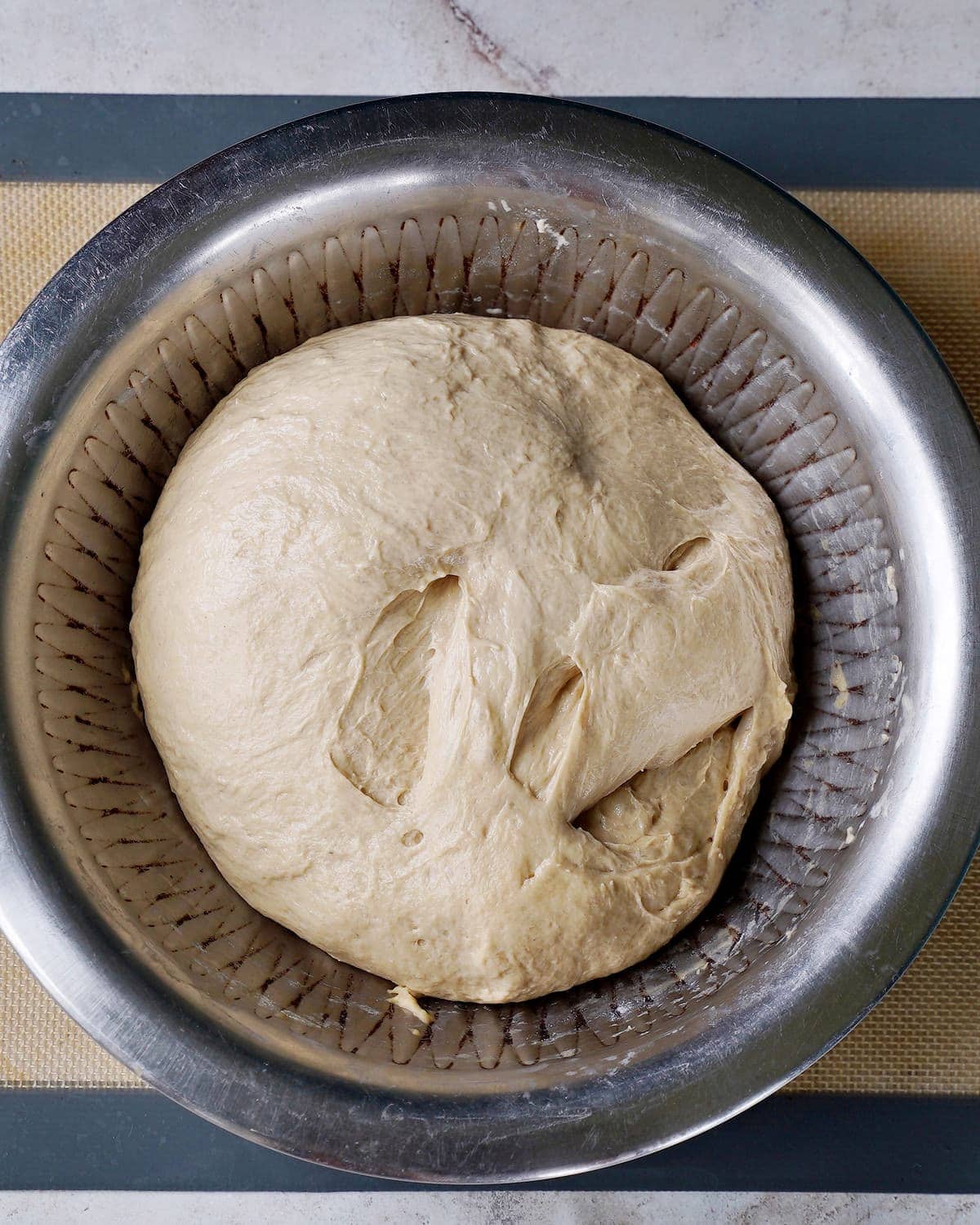
Step 2: Prepare the poppy seed filling
- Meanwhile, grind the poppy seeds in an electric spice grinder or blender. Then add all the poppy seed filling ingredients to a saucepan and heat over medium heat to allow them to simmer for one minute. Then set aside- the poppy seed filling will thicken as it cools.
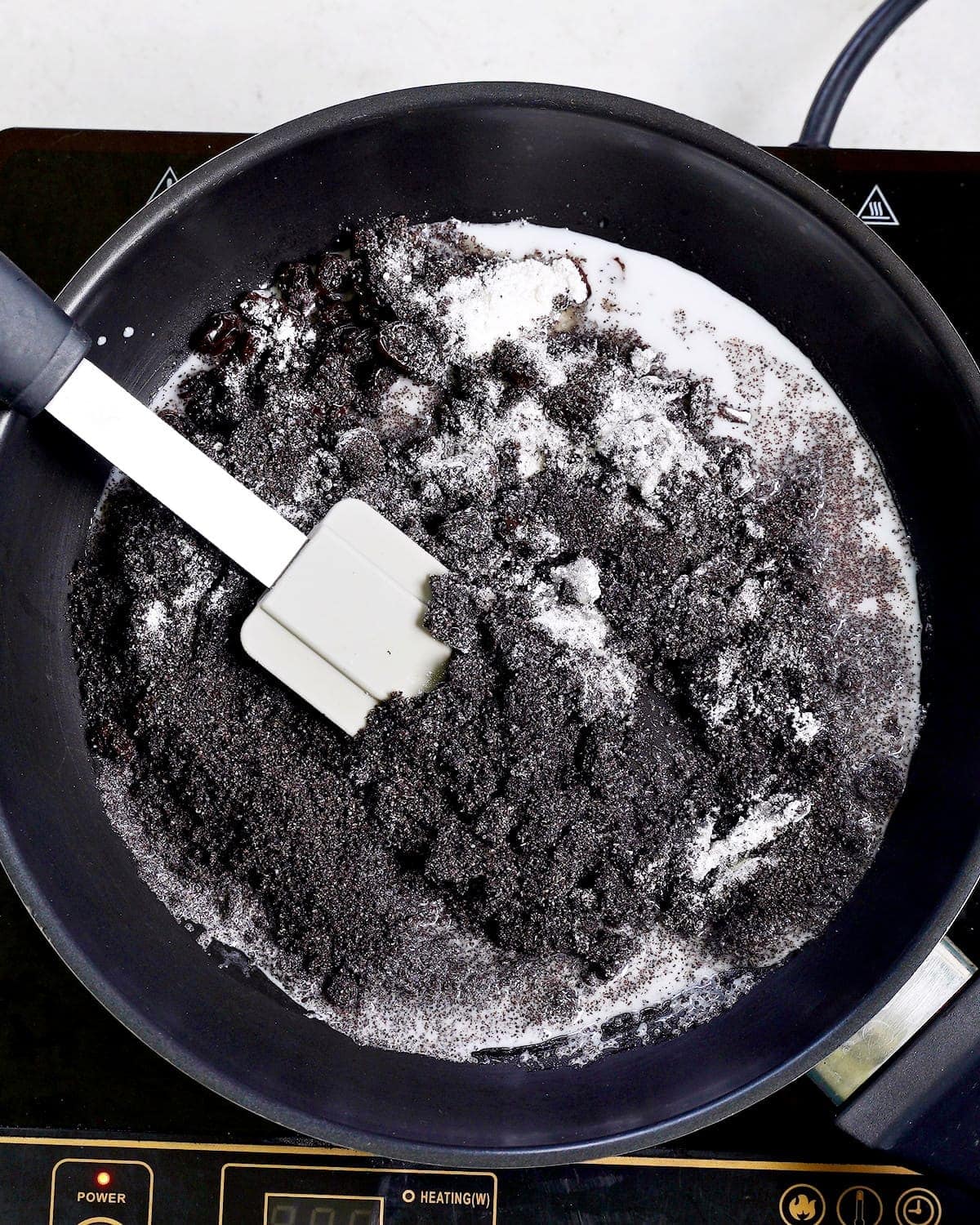
Step 3: Assemble the yeast rolls
- Preheat the oven to 356 °F / 180 °C and grease a baking pan with vegan butter.
- Then, place the dough on a lightly floured piece of parchment paper (or silicone mat) and roll into a rectangle (around 1 cm thick).
- Carefully spread the poppy seed filling over the dough rectangle, leaving the top 5-8 cm bare.
- Next, roll the dough; be careful doing this as it is fragile as it’s gluten-free and egg-free.
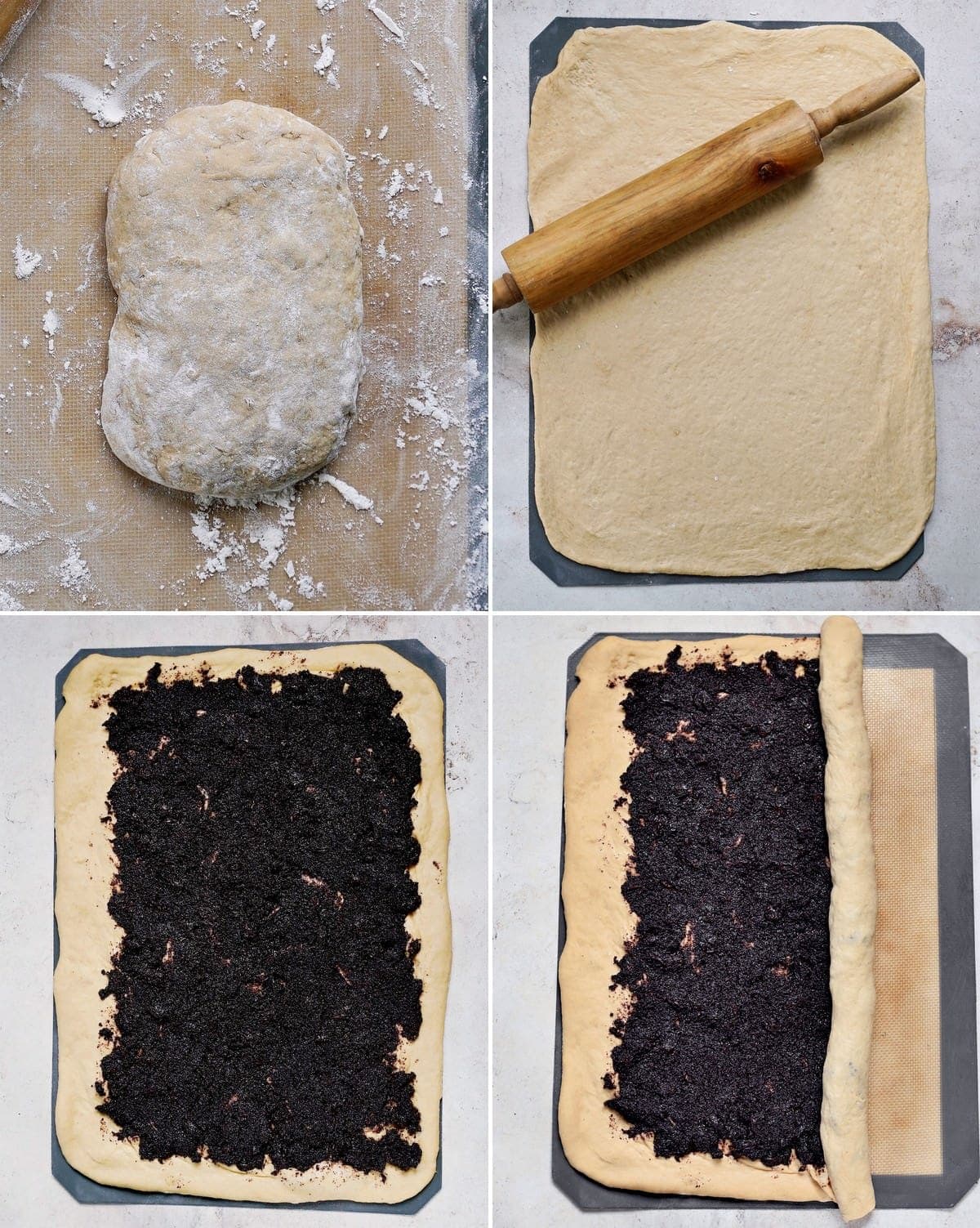
Step 4: Bake the poppy seed rolls
- Cut the roll into 12 even poppy seed rolls and place them in the prepared baking tray.
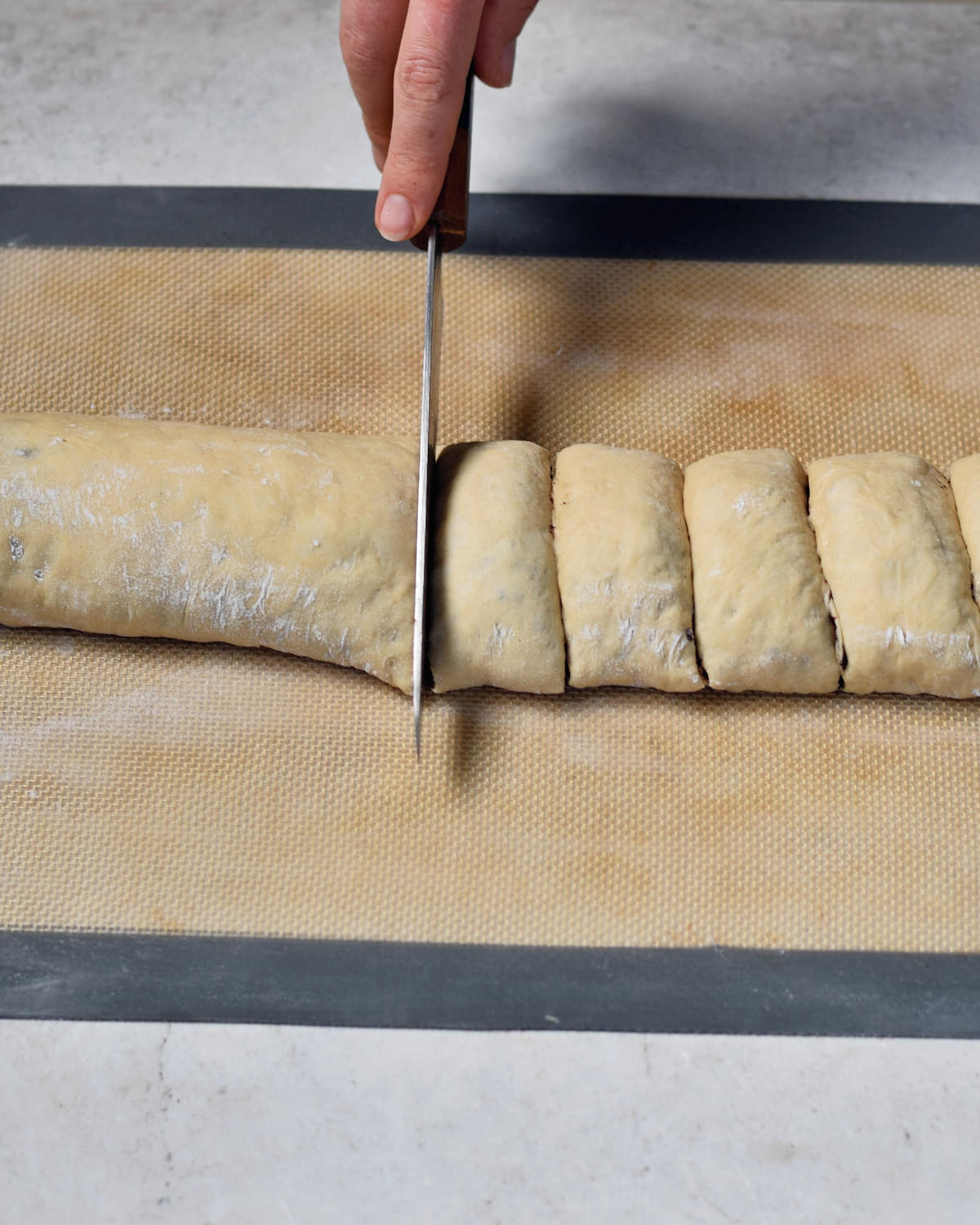
- Then bake in the oven for 25-30 minutes.
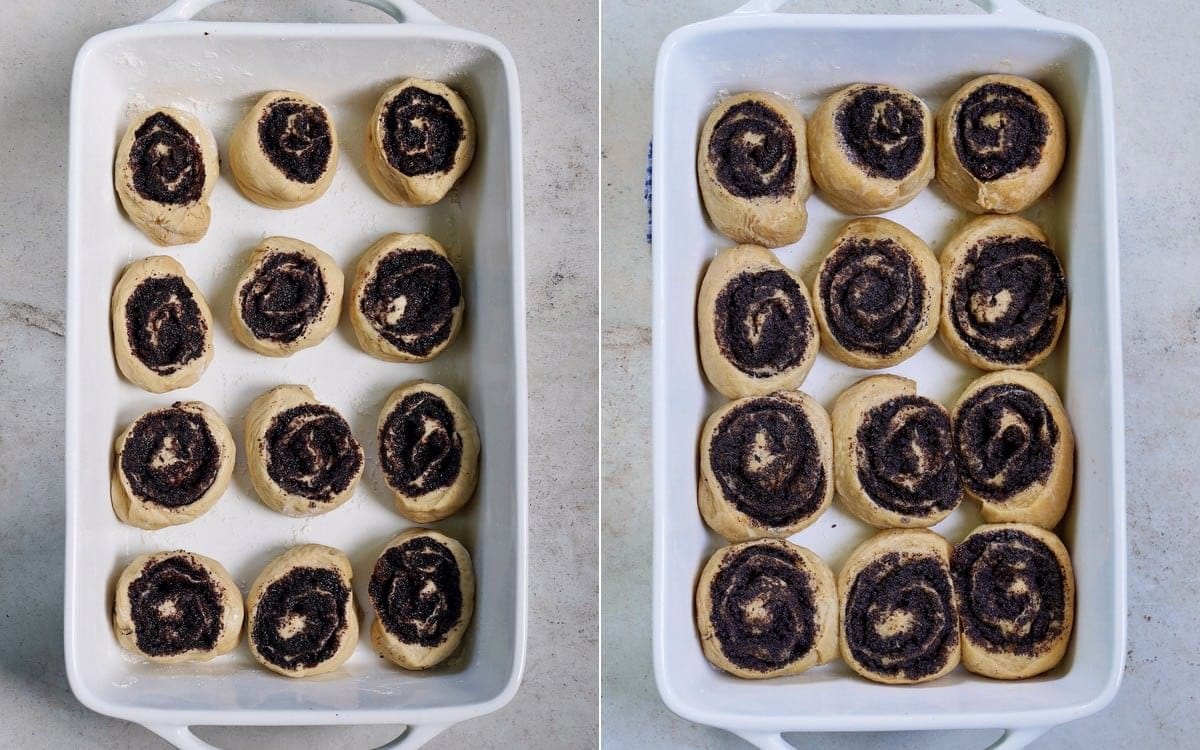
- Optionally prepare the icing. To do so, mix the powdered sugar (or Erythritol) with a few teaspoons of dairy-free milk and a few drops of lemon juice until it reaches the correct consistency.
- Once baked, allow the rolls to cool a bit before drizzling them with icing – then enjoy!
They taste best warm straight out of the oven while at their freshest and wonderfully soft.
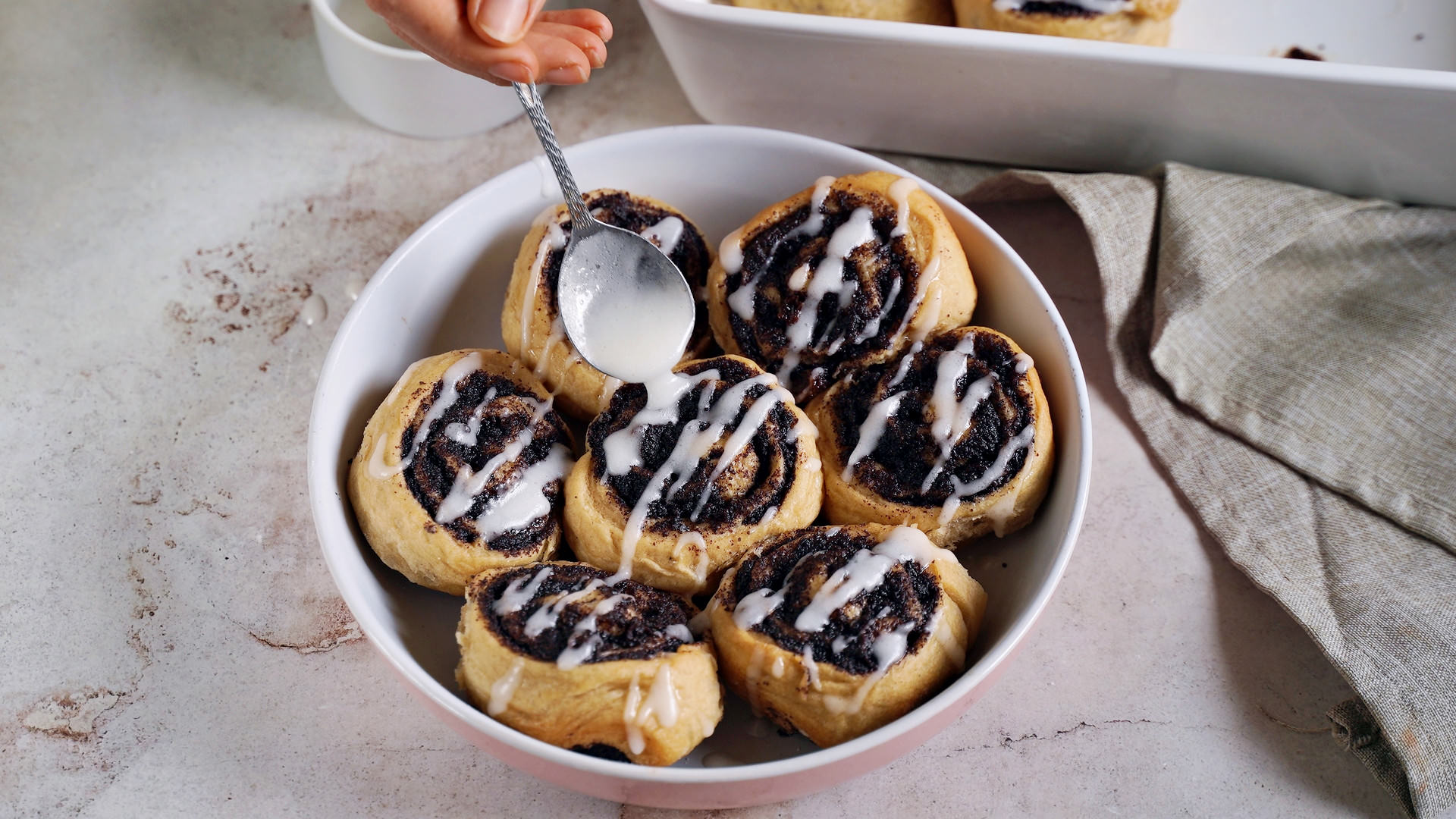
How to Store and Reheat?
To Store: Store leftovers in an airtight container/bag in the refrigerator for 2-3 days; over time, they will dry out
To freeze: Allow the rolls to cool before laying them on a baking sheet. Freeze until hard and then transfer to an airtight container/bag and store for up to two months.
To reheat: Sprinkle them lightly with a little water and heat in the oven for a few minutes, until warmed. This will help slightly soften them again, too. You could also reheat them in the microwave.
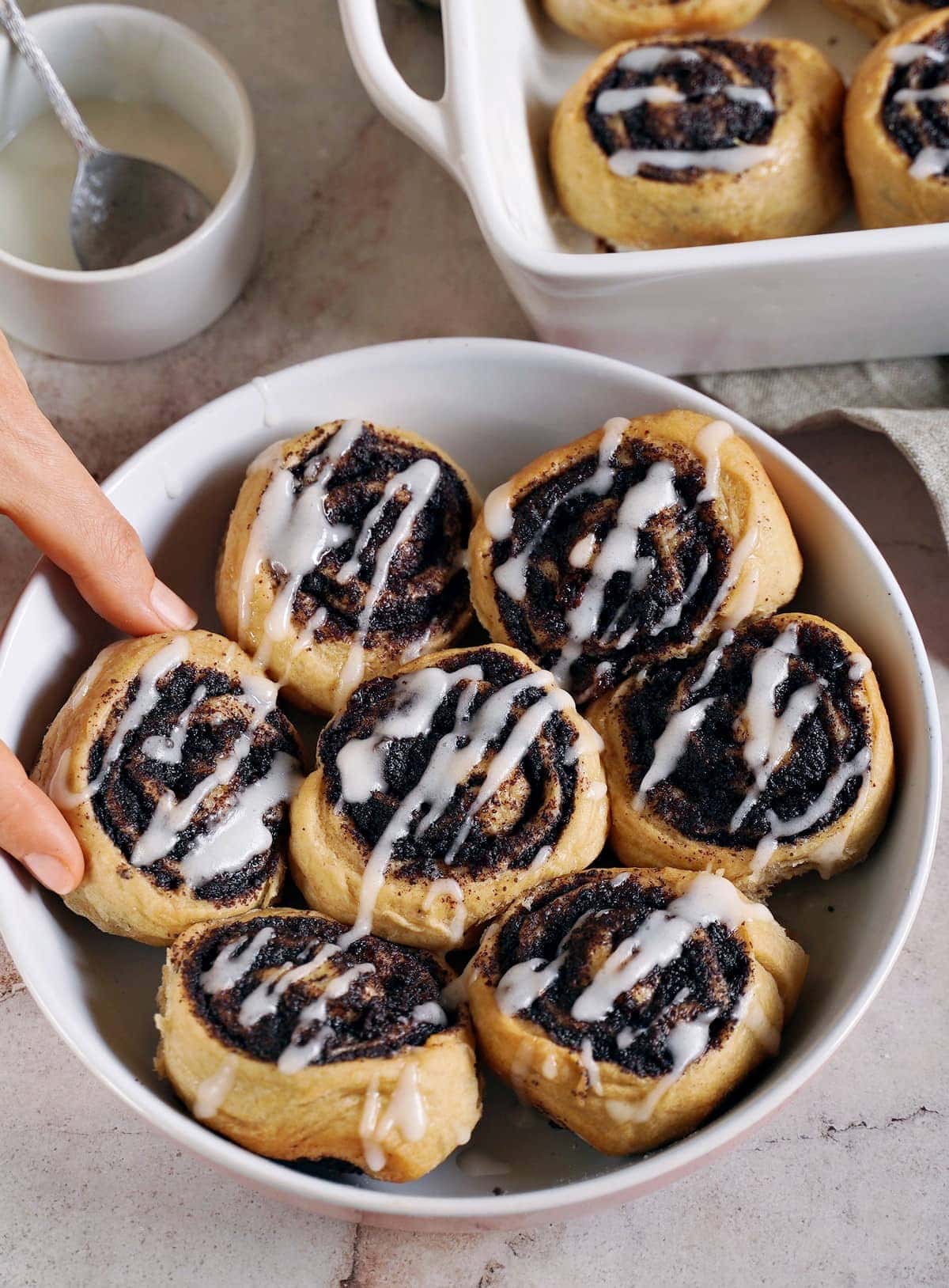
Recipe Notes
- Test your yeast: If you aren’t sure if your yeast is ‘fresh,’ then test some before trying this recipe. To do so, add a packet (2 1/4 tsp) of yeast with 1 tsp sugar and ¼ cup of warm water and allow it to proof for 5-10 minutes. If it froths/bubbles up, it’s good to go. If not, you need new yeast.
- For shiny rolls: Use an ‘egg wash’ equivalent by brushing the rolls with a bit of melted coconut oil or a milk/agave mixture.
- Bake a full roll: Instead of chopping the rolled dough into pieces, tuck all the edges under to form one big ‘loaf.’ Don’t roll it too tightly and poke it with a fork a couple of times before baking to allow steam to escape (so the filling doesn’t seep out). The baking time will increase to 35-40 minutes, or until golden brown on top.
- The gluten-free flour blend: I had the best results with the flour blend stated in the recipe. If you use a different blend, the results will differ as each flour absorbs differently. Bob’s Red Mill GF all-purpose flour may work, but I haven’t tried.
- Using all-purpose flour: If you’re not gluten-free, you can also use regular flour (or spelt flour). Check the ingredient amounts in the recipe card notes. The directions are similar, except you will have to knead the dough for about 8 minutes.
- Poppyseed filling: You can increase the filling flavor with a little cinnamon, nutmeg, or vanilla.

More Delicious Bakes
- Healthy Oatmeal Chocolate Chip Bars
- Soft Coconut Sugar Cookies
- German Hazelnut Cookies
- Zimtsterne (Cinnamon Stars)
- Apple Strudel (Apfelstrudel)
If you try this recipe for poppy seed rolls, I’d love a comment and ★★★★★ recipe rating below. Also, please don’t forget to tag me in re-creations on Instagram or Facebook with @elavegan #elavegan – I love seeing them.
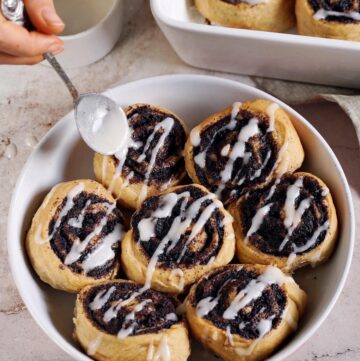
Poppy Seed Rolls
Ingredients
Gluten-Free Dough
- 1 cup (240 g) dairy-free milk lukewarm
- 3 heaped tbsp (40 g) cane sugar or coconut sugar
- 1 tbsp (10 g) fresh yeast or 1 tsp (3 g) dry yeast
- 1 cup (160 g) brown rice flour (see notes for a version with regular flour)
- 5/8 cup (75 g) buckwheat flour
- 3 tbsp (25 g) tapioca flour
- 2 1/2 tbsp (25 g) psyllium husk powder
- 3 tbsp (40 g) vegan butter softened
- 3/4 tbsp (10 g) apple cider vinegar
- 1 pinch of salt
Poppy Seed Filling
- 7/8 cup (130 g) poppy seeds
- 1/2 cup (120 g) dairy-free milk + more if needed
- 1/2 cup (60 g) icing sugar or powdered Erythritol
- 3/8 cups (60 g) raisins
Instructions
Dough
- You can watch the short video for visual instructions.Add the yeast and 1 teaspoon of sugar to a small saucepan and pour in the lukewarm milk (approx. 35-40° C / 100° F). Set aside for a few minutes.
- Combine the flours, psyllium husk powder, salt, and the remaining sugar in a bowl and mix with a whisk.
- Stir in the yeast mixture, apple cider vinegar, and softened vegan butter, then knead the dough for a few minutes with your hands or use a stand mixer with the dough hook. If the dough is too dry, add a little more milk.
- Add the dough back to the bowl, cover it with a damp kitchen towel and let the dough rise in a warm place for about 60 minutes.
Filling
- Grind the poppy seeds in an electric spice grinder or blender, then transfer all filling ingredients to a saucepan or skillet, heat and let simmer for one minute. Set aside.
Assemble
- Preheat the oven to 356 °F / 180 °C and grease a baking pan with vegan butter.
- Place the dough on a floured piece of parchment paper or a silicone mat. Roll it out with a rolling pin into a rectangle about 1 cm thick.
- Spread the poppy seed filling on the dough, but leave out the top 5-8 cm.
- Roll up the dough with your fingers. Since the dough is gluten-free and egg-free, and therefore somewhat brittle, it should be rolled up carefully.
- Cut the dough roll into 12 equal pieces and place them in the baking pan. Bake in the oven for about 25 minutes (the baking time may vary depending on the oven).
Icing (optional)
- To make icing, simply mix 70 g of powdered sugar (or powdered Erythritol) with a few teaspoons of dairy-free milk and a few drops of lemon juice in a small bowl until it has the right consistency.
- Let the poppy seed rolls cool a bit, then drizzle the icing on top and enjoy!
Notes
- 1/2 cup dairy-free milk (120 g) + a little more if needed
- 3 heaped tbsp cane sugar, or coconut sugar (40 g)
- 1 tbsp (10 g) fresh yeast or 1 tsp (3 g) dry yeast
- 2 cups all-purpose flour (250 g)
- 2 tbsp vegan butter (30 g), softened
- 1 tsp apple cider vinegar
- 1 pinch of salt
- If you're not gluten-free, you can use the above recipe. The directions are similar, except you will have to knead the dough for about 8 minutes.
- They taste the best fresh out of the oven when they are still warm and soft. You can store the remaining rolls in the fridge, but they will dry out a bit after a while. I recommend reheating them in the oven for a few minutes (preferably sprinkled with water beforehand) if you want to eat them the next day.
- Please do not omit the psyllium husk powder in the gluten-free version. It is very useful in gluten-free baking. Psyllium husks are fibrous and absorb a lot of liquid. Xanthan gum might work as an alternative.
- I had the best GF result with the flour blend specified in this recipe. If you use a different flour blend, the result will be different because other gluten-free flours absorb different amounts of liquid. You can probably get a similarly good result with a different flour blend (such as Bob's Red Mill), but since I haven't tried it myself, I can't say how much the result will differ from my flour blend.
Nutrition information is an estimate and has been calculated automatically
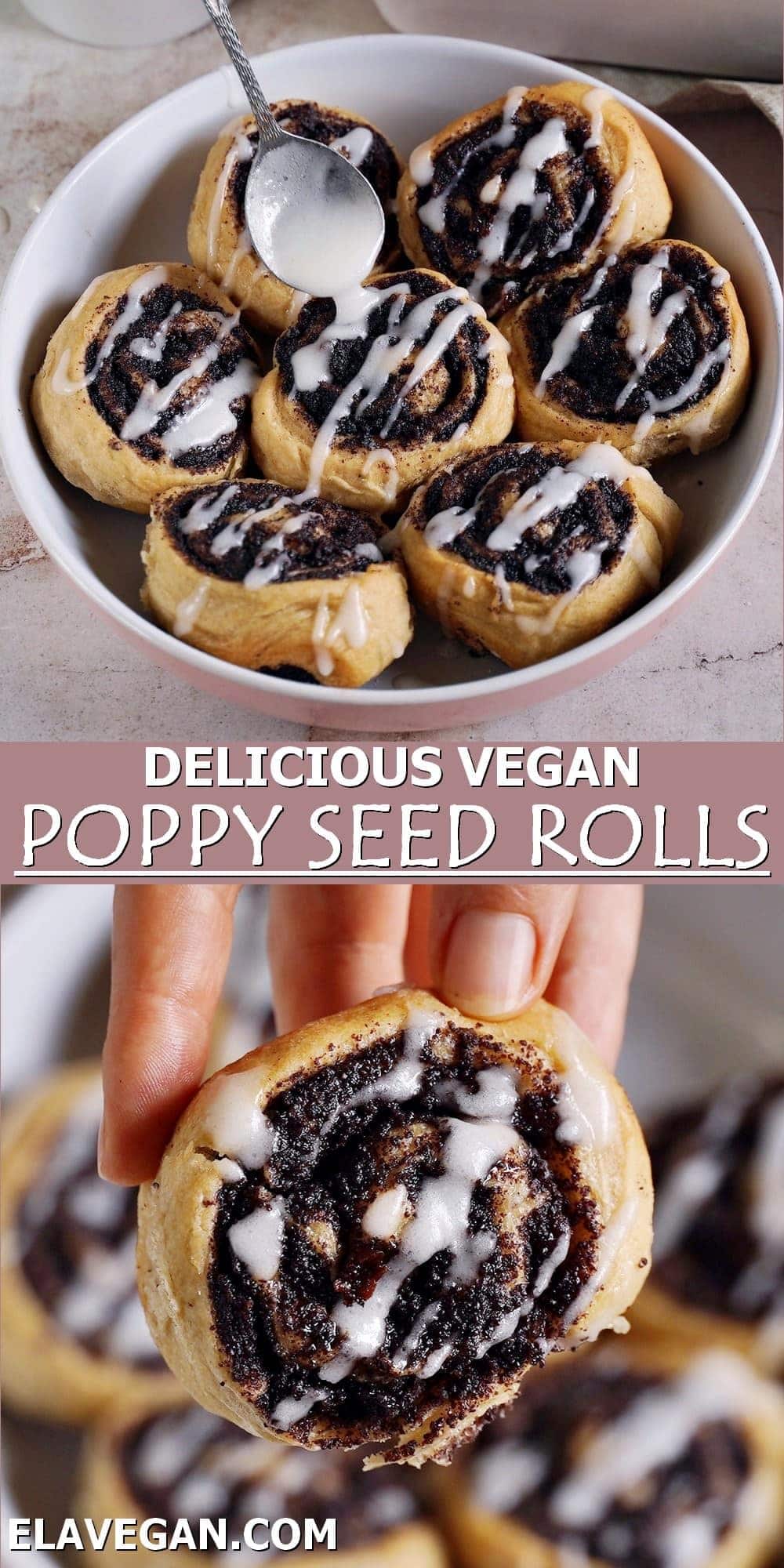

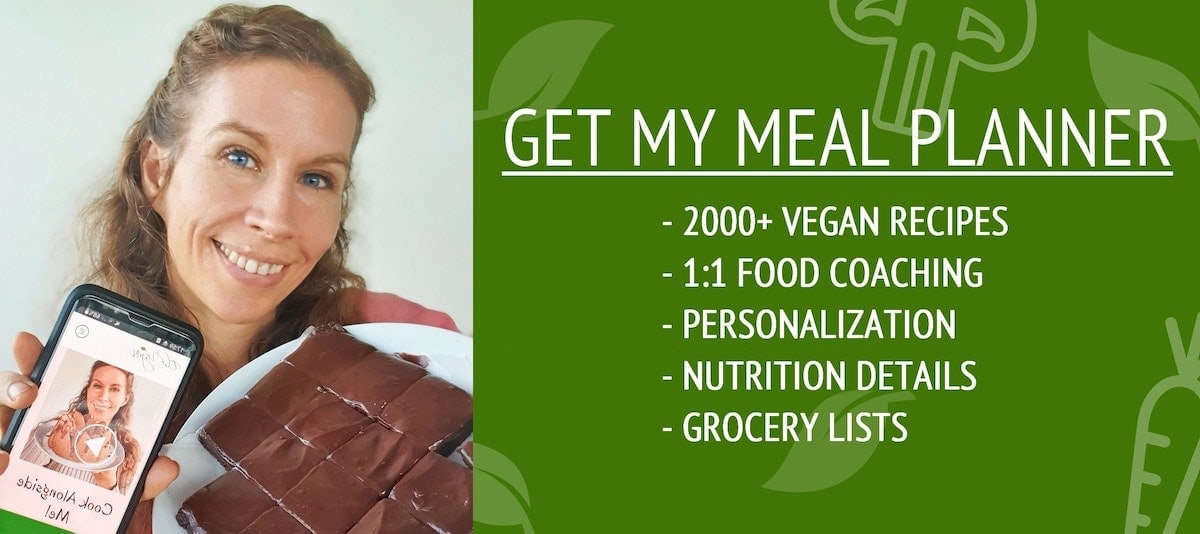


Such a soft and beautiful roll. Super tasty! Since the brown rice flour is a bit strong, I might experiment with white rice flour and see if it tastes better.
Hey, I am so glad you liked it! Yes, white rice flour should work too. 🙂
Really nice, soft dough! Maybe it can be done without yeast and for something savory?
Hi Min, thanks for your feedback. I haven’t tried replacing the yeast yet. Something savory should be totally possible if leaving out most of the sweetener. 🙂